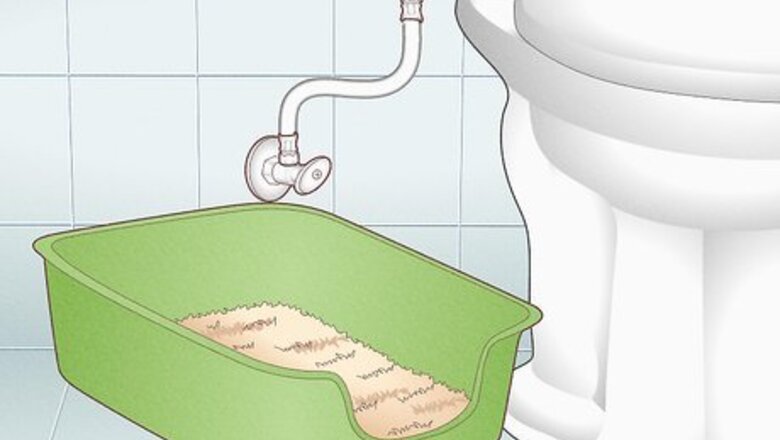
views
Training Your Cat to Use the Toilet
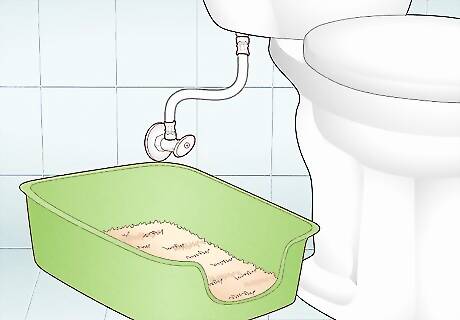
Move your cat’s litter box to the bathroom for a week. Choose the bathroom in your home that your cat has easiest access to. Move the cat's litter box into the bathroom and place it near the toilet, and give them a week or 2 to get comfortable doing their business here.
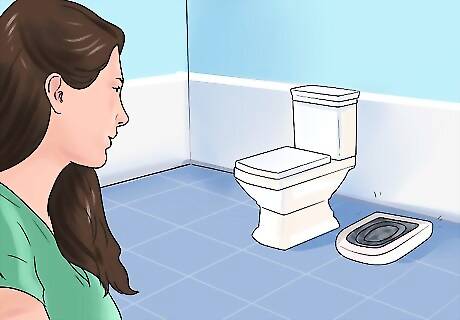
Create or purchase a cat toilet training seat. A cat toilet training seat, like a Litter Kwitter or CitiKitty, is a device placed over the toilet bowl and filled with litter. As your cat acclimates to the toilet, a larger and larger hole is exposed in the center, until your cat is using the toilet as normal. These are available for around $30-50 at retail pet stores, or you might make your own: Simply fill a shallow, disposable aluminum cooking pan that’s large enough to cover your toilet bowl with about 1 in (2.5 cm) of your cat’s litter.

Raise the litter box 3–4 in (7.6–10.2 cm) every few days. In order to transition your cat from litter box to toilet, gradually raise the litter box up near the toilet seat. Every 2-3 days, place the litter box on a slightly higher foundation. Use cardboard boxes, stacks of books, or anything else that might give it some sturdy altitude. Keep doing this until the litter box is at about the same height as the toilet. Also, move the litter box 3–4 in (7.6–10.2 cm) nearer to the toilet every time you lift it.
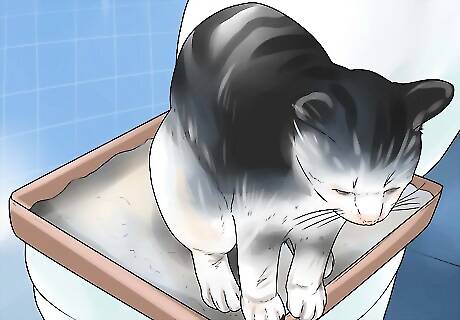
Place the litter box on top of the toilet seat for 3-4 days. Once the litter box is on level with the toilet seat, place it on top of the toilet seat. Leave it there for a few days. This is about how long it will take your cat to get comfortable eliminating on the toilet. Veterinarian Dr. Brian Bourquin tells us that training cats is “all about positive reinforcement.” Whenever you witness your cat use the litter box, offer them praise and treats to tell them to keep it up.
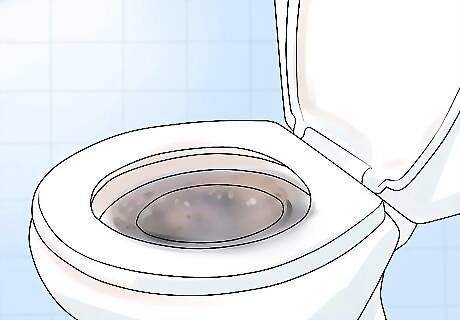
Replace the litter box with a training seat filled with flushable litter. Once your cat is comfortably using the litter box without any accidents, it's time to use your training seat! Secure your training seat on the toilet according to the manufacturer’s instructions, but don’t take out any of the inserts, then fill it with 1–2 in (2.5–5.1 cm) of flushable litter. Or, if you’re using a homemade tray: Duct tape the homemade tray to the seat of your toilet, ensuring there are no holes and that it doesn’t shift. Then, fill it with 1–2 in (2.5–5.1 cm) of flushable litter. Note that while you train your cat, you’ll have to remove the tray to use the toilet yourself. Or, simply use a different toilet, if possible.

Open a new hole in the training tray each week. Give your cat a few days to get used to eliminating in the training tray, without any holes. Once they use it without any accidents, remove the smallest insert in your tray, and let your cat adjust for another several days before removing the next. If you're using a homemade tray, use scissors or a utility knife to cut a hole about 3–4 in (7.6–10.2 cm) in diameter in the center of the tray, and widen the hole by about 3–4 in (7.6–10.2 cm) each increment. Also, gradually decrease the amount of litter you're using. Each time your cat eliminates in the pan, replace the litter with a slightly smaller amount than before.

Remove the training seat when your cat is comfortable. After about 2-3 weeks of increasing the size of the hole or training trays, remove the training seat completely. Your cat should now be comfortable eliminating straight into the toilet rather than a litter box. We don’t recommend teaching your cat to flush. They may get a little too into it and drive up your water bill.
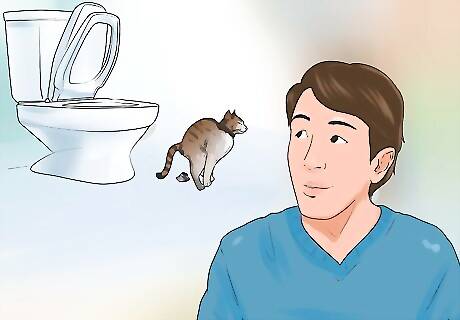
Stay patient, and avoid pressuring your cat. Toilet training usually takes about 6 weeks, and that’s without setbacks. If your cat is resistant to a step in the process, they might begin eliminating elsewhere. If this occurs, take a step back in toilet training. It's also a good idea to have a lot of cleaning supplies on hand when toilet training. In all likelihood, there will be at least one accident along the way. Lay pee pads down around your toilet to catch any mess made by spraying males, or tracked across the floor after a toilet session. Don’t pressure your cat if toilet training stresses them out. If they begin to behave abnormally, ditch the toilet training and reintroduce the litter box. Keep in mind that toilet training just doesn’t work for some cats—as many as 30%. If your kitty is one of them, consider an alternative, like hidden or self-cleaning litter boxes.
Benefits & Drawbacks of Toilet Training Your Cat
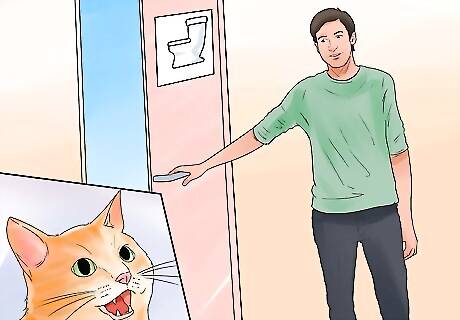
Benefits Of course, toilet training is a mess-free alternative to litter training your cat. A toilet trained cat is lower maintenance, and likely less expensive in the long run, since you’re saving money on litter. You also don’t need to get your hands dirty tidying a litter box each day, and cleaning it each week. Instead, your cat goes where you go!
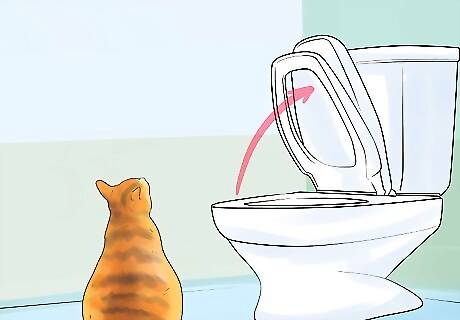
Drawbacks Toilet training isn’t for every cat, and some vets recommend against it. It may not work for especially skittish or wary cats, who may never feel comfortable approaching a toilet that way. What’s more, older cats may have trouble reaching the toilet, and the slick surface of the seat isn’t very forgiving to their grip or sturdiness. Also: If your cat ever falls into the toilet, they may not want to use it anymore, causing litter troubles and booting you right back to a litter box. Cats are naturally inclined to eliminate in sand-like litter, where they can bury their waste. It can be stressful for cats to try and learn otherwise. The pose needed to use a toilet may also be stressful. Young kittens should never use a toilet, as they may not be able to climb out if they fall in. It’s much harder to monitor your cat’s waste for signs of disease, especially urinary indicators, if they’re going in a toilet rather than using a litter box. Finally, it’s not always pretty sharing a toilet with your cat. You’ll have to flush for them, or wait for them to finish to do your own business.
Toilet Training Alternatives
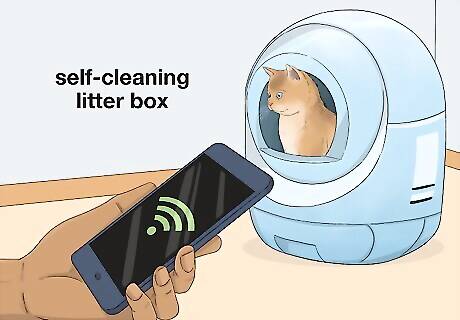
Use a self-cleaning litter box if you want to cut down on litter labor. If you’re looking to go more hands-off with your cat’s bathroom routine, but toilet training isn’t right for you, consider an automatic litter box. These routinely tidy the litter pan of poo and urine, so you don’t have to. Of course, you’ll still need to empty the collected eliminations about once a week.

Disguise your litter box as furniture to hide it. If your beef with your cat’s litter box is more about it being an eyesore, disguise it! Some cat owners place their kitty’s box in a cabinet, and install a kitty door in the cabinet door for access. Or, purchase a litter box designed to look like a household fixture, like a vase or end table, to hide it in plain sight.
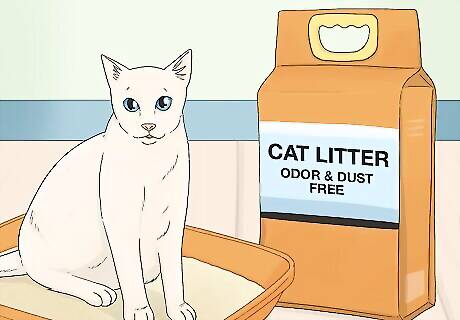
Use an odor-free or dust-free litter to cut down on irritants. If your cat’s litter box tends to exude an unpleasant aroma, or gives off unsavory particles, try a scented or odor-free litter instead. There are also dust-free litters, like pelletted litters, that help keep the mess contained. Keep in mind that cats can be picky about the kind of litter they use. Keep trying multiple litters to see which your cat will accept.




















Comments
0 comment